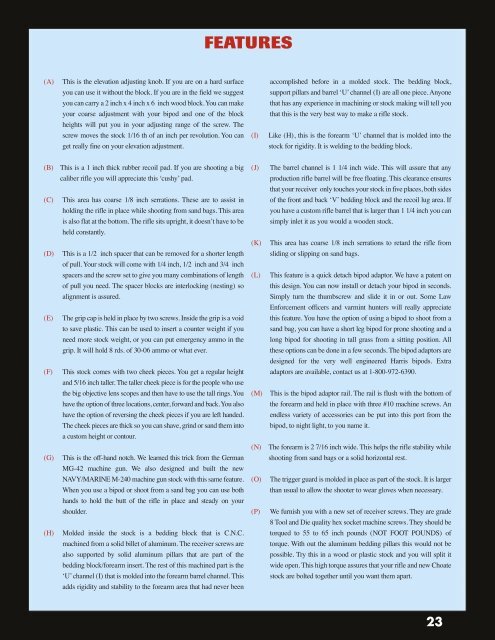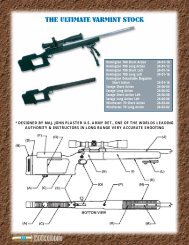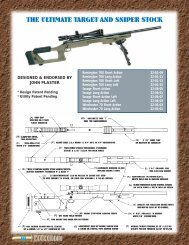Master Products Catalog - Choate Machine & Tool, Inc.
Master Products Catalog - Choate Machine & Tool, Inc.
Master Products Catalog - Choate Machine & Tool, Inc.
You also want an ePaper? Increase the reach of your titles
YUMPU automatically turns print PDFs into web optimized ePapers that Google loves.
(A) This is the elevation adjusting knob. If you are on a hard surface<br />
you can use it without the block. If you are in the field we suggest<br />
you can carry a 2 inch x 4 inch x 6 inch wood block. You can make<br />
your coarse adjustment with your bipod and one of the block<br />
heights will put you in your adjusting range of the screw. The<br />
screw moves the stock 1/16 th of an inch per revolution. You can<br />
get really fine on your elevation adjustment.<br />
(B) This is a 1 inch thick rubber recoil pad. If you are shooting a big<br />
caliber rifle you will appreciate this ‘cushy’ pad.<br />
(C) This area has coarse 1/8 inch serrations. These are to assist in<br />
holding the rifle in place while shooting from sand bags. This area<br />
is also flat at the bottom. The rifle sits upright, it doesn’t have to be<br />
held constantly.<br />
(D) This is a 1/2 inch spacer that can be removed for a shorter length<br />
of pull. Your stock will come with 1/4 inch, 1/2 inch and 3/4 inch<br />
spacers and the screw set to give you many combinations of length<br />
of pull you need. The spacer blocks are interlocking (nesting) so<br />
alignment is assured.<br />
(E) The grip cap is held in place by two screws. Inside the grip is a void<br />
to save plastic. This can be used to insert a counter weight if you<br />
need more stock weight, or you can put emergency ammo in the<br />
grip. It will hold 8 rds. of 30-06 ammo or what ever.<br />
(F) This stock comes with two cheek pieces. You get a regular height<br />
and 5/16 inch taller. The taller cheek piece is for the people who use<br />
the big objective lens scopes and then have to use the tall rings. You<br />
have the option of three locations, center, forward and back. You also<br />
have the option of reversing the cheek pieces if you are left handed.<br />
The cheek pieces are thick so you can shave, grind or sand them into<br />
a custom height or contour.<br />
(G) This is the off-hand notch. We learned this trick from the German<br />
MG-42 machine gun. We also designed and built the new<br />
NAVY/MARINE M-240 machine gun stock with this same feature.<br />
When you use a bipod or shoot from a sand bag you can use both<br />
hands to hold the butt of the rifle in place and steady on your<br />
shoulder.<br />
(H) Molded inside the stock is a bedding block that is C.N.C.<br />
machined from a solid billet of aluminum. The receiver screws are<br />
also supported by solid aluminum pillars that are part of the<br />
bedding block/forearm insert. The rest of this machined part is the<br />
‘U’ channel (I) that is molded into the forearm barrel channel. This<br />
adds rigidity and stability to the forearm area that had never been<br />
FEATURES<br />
accomplished before in a molded stock. The bedding block,<br />
support pillars and barrel ‘U’ channel (I) are all one piece. Anyone<br />
that has any experience in machining or stock making will tell you<br />
that this is the very best way to make a rifle stock.<br />
(I) Like (H), this is the forearm ‘U’ channel that is molded into the<br />
stock for rigidity. It is welding to the bedding block.<br />
(J) The barrel channel is 1 1/4 inch wide. This will assure that any<br />
production rifle barrel will be free floating. This clearance ensures<br />
that your receiver only touches your stock in five places, both sides<br />
of the front and back ‘V’ bedding block and the recoil lug area. If<br />
you have a custom rifle barrel that is larger than 1 1/4 inch you can<br />
simply inlet it as you would a wooden stock.<br />
(K) This area has coarse 1/8 inch serrations to retard the rifle from<br />
sliding or slipping on sand bags.<br />
(L) This feature is a quick detach bipod adaptor. We have a patent on<br />
this design. You can now install or detach your bipod in seconds.<br />
Simply turn the thumbscrew and slide it in or out. Some Law<br />
Enforcement officers and varmint hunters will really appreciate<br />
this feature. You have the option of using a bipod to shoot from a<br />
sand bag, you can have a short leg bipod for prone shooting and a<br />
long bipod for shooting in tall grass from a sitting position. All<br />
these options can be done in a few seconds. The bipod adaptors are<br />
designed for the very well engineered Harris bipods. Extra<br />
adaptors are available, contact us at 1-800-972-6390.<br />
(M) This is the bipod adaptor rail. The rail is flush with the bottom of<br />
the forearm and held in place with three #10 machine screws. An<br />
endless variety of accessories can be put into this port from the<br />
bipod, to night light, to you name it.<br />
(N) The forearm is 2 7/16 inch wide. This helps the rifle stability while<br />
shooting from sand bags or a solid horizontal rest.<br />
(O) The trigger guard is molded in place as part of the stock. It is larger<br />
than usual to allow the shooter to wear gloves when necessary.<br />
(P) We furnish you with a new set of receiver screws. They are grade<br />
8 <strong>Tool</strong> and Die quality hex socket machine screws. They should be<br />
torqued to 55 to 65 inch pounds (NOT FOOT POUNDS) of<br />
torque. With out the aluminum bedding pillars this would not be<br />
possible. Try this in a wood or plastic stock and you will split it<br />
wide open. This high torque assures that your rifle and new <strong>Choate</strong><br />
stock are bolted together until you want them apart.<br />
23




